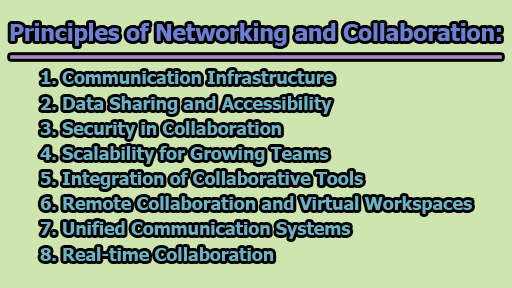Principles of Networking and Collaboration:
In the contemporary digital landscape, the principles of networking and collaboration play a pivotal role in shaping the way individuals and organizations connect, communicate, and achieve their goals. Networking involves the establishment and maintenance of connections between devices, systems, or people, while collaboration focuses on working together towards a common objective. In the rest of this article, we will delve into the fundamental principles of networking and collaboration.
Networking Principles:
1. Interoperability: Interoperability is a cornerstone principle in networking, emphasizing the seamless communication and interaction between diverse systems and devices. It ensures that different technologies can work together cohesively, allowing for efficient data exchange and functionality across interconnected entities.
2. Scalability: Scalability is essential for a network to adapt to changing requirements and growth. A scalable network can handle an increasing number of devices, users, or data traffic without compromising performance. This principle is critical in ensuring that networks can expand to accommodate evolving needs.
3. Reliability: Reliability underscores the importance of maintaining consistent and dependable network services. Redundancy, fault tolerance, and robust infrastructure are crucial elements to minimize downtime and ensure that networks remain operational even in the face of challenges or failures.
4. Security: Security is a paramount concern in networking, aiming to protect data, systems, and communication channels from unauthorized access, breaches, or malicious activities. Encryption, authentication mechanisms, and firewalls are integral components in establishing a secure network environment.
5. Flexibility: The flexibility of a network allows it to adapt to changing conditions, technologies, and user requirements. A flexible network architecture enables the integration of new technologies and services without causing disruptions to existing functionalities.
6. Quality of Service (QoS): QoS is a measure of the performance and reliability of a network. It ensures that certain applications or services receive priority in terms of bandwidth, latency, and other performance metrics, guaranteeing a consistent user experience.
Collaboration Principles:
1. Communication: Effective communication is the cornerstone of collaboration. It involves the clear exchange of information, ideas, and feedback among team members. Various communication channels, such as messaging platforms, video conferencing, and collaborative documents, contribute to fostering a cohesive working environment.
2. Shared Goals and Objectives: Successful collaboration hinges on a shared understanding of goals and objectives. Team members must align their efforts towards a common purpose, fostering a sense of unity and commitment to achieving collective success.
3. Trust and Transparency: Trust is the foundation of collaboration. Team members should have confidence in each other’s abilities and intentions. Transparency in communication and decision-making processes enhances trust and promotes a positive collaborative culture.
4. Flexibility and Adaptability: Collaboration requires flexibility to adapt to changing circumstances, new information, and evolving project requirements. A collaborative team should be open to adjusting strategies and embracing new ideas to achieve optimal outcomes.
5. Conflict Resolution: Conflicts are inevitable in collaborative endeavors. Effective collaboration involves the ability to address conflicts constructively, seeking resolutions that consider the perspectives of all team members. Open communication and a willingness to compromise are key in conflict resolution.
6. Technology Integration: Leveraging collaborative tools and technologies is essential for modern teamwork. Platforms such as project management software, document sharing tools, and virtual collaboration spaces enhance efficiency and facilitate seamless information exchange among team members.
Interplay Between Networking and Collaboration:
The interplay between networking and collaboration is a dynamic relationship that significantly influences the way individuals and organizations work together in the digital age. The seamless integration of robust networking principles with effective collaboration practices creates a synergistic environment where communication, information sharing, and teamwork flourish.
1. Communication Infrastructure: Networking serves as the backbone for the communication infrastructure that collaboration relies on. High-speed, reliable networks enable real-time communication through various channels, such as video conferencing, instant messaging, and voice calls. The quality of these communication channels is directly influenced by networking principles like bandwidth management, low latency, and Quality of Service (QoS). A well-designed network ensures that collaborative teams can engage in fluid and responsive communication, irrespective of geographical distances.
2. Data Sharing and Accessibility: Collaboration thrives on the ability to share and access data seamlessly. Networking principles such as data transmission protocols, file-sharing mechanisms, and secure access control play a pivotal role in enabling efficient data sharing. Teams can collaborate on documents, share resources, and synchronize information in real-time, leveraging a network infrastructure that supports high-speed data transfer and accessibility across diverse devices and locations.
3. Security in Collaboration: Security is a paramount concern in both networking and collaboration. The interplay involves integrating robust security measures into the network infrastructure to safeguard collaborative activities. Encryption, authentication, and secure communication protocols ensure that sensitive information shared during collaboration remains protected from unauthorized access or data breaches. The collaboration tools and platforms themselves rely on a secure network foundation to prevent potential vulnerabilities.
4. Scalability for Growing Teams: Collaboration within organizations often involves dynamic and growing teams. Networking principles of scalability become crucial in this context. A scalable network infrastructure accommodates the increasing demands of growing teams, supporting additional users, devices, and data traffic without compromising performance. This scalability ensures that collaborative efforts can scale seamlessly to meet the evolving needs of organizations.
5. Integration of Collaborative Tools: Collaborative tools, such as project management software, document sharing platforms, and virtual workspaces, heavily rely on networking infrastructure for their functionality. Integration of these tools into the network fabric ensures smooth operations and unhindered access to collaborative resources. A well-architected network supports the data traffic generated by these tools, facilitating efficient collaboration and enhancing the overall productivity of teams.
6. Remote Collaboration and Virtual Workspaces: The evolution of networking technologies has played a pivotal role in the rise of remote collaboration and virtual workspaces. High-speed internet, secure VPNs, and cloud computing have transformed the way teams collaborate across different locations. Networking principles like low latency and reliable connectivity contribute to the seamless integration of remote work into collaborative practices, allowing teams to collaborate effectively regardless of physical distances.
7. Unified Communication Systems: The interplay between networking and collaboration is evident in the development of unified communication systems. These systems integrate various communication channels, including voice, video, messaging, and email, into a cohesive platform. Networking principles ensure that these channels operate seamlessly, providing a unified and consistent experience for team members engaged in collaborative activities.
8. Real-time Collaboration: Real-time collaboration, where team members work on shared documents simultaneously or engage in live discussions, relies on a network infrastructure capable of handling instant data updates. Networking principles of low latency and high bandwidth support real-time collaboration, ensuring that changes made by one team member are quickly reflected for others, fostering a sense of immediacy and responsiveness.
In conclusion, the principles of networking and collaboration are integral components of the modern digital landscape. Networking provides the foundation for seamless communication, data exchange, and collaboration, while collaboration relies on efficient networking infrastructure to support real-time interactions and shared access to resources. Organizations and individuals can enhance their productivity, innovation, and success by understanding and applying these principles in a cohesive manner. As technology continues to evolve, staying abreast of emerging trends in networking and collaboration will be essential for achieving sustained growth and competitiveness in an interconnected world.

Former Student at Rajshahi University










